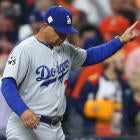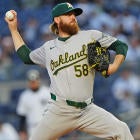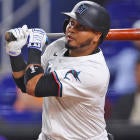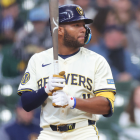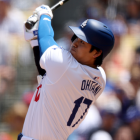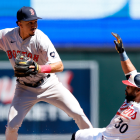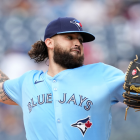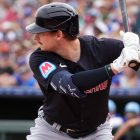A hallmark of Rob Manfred's tenure as MLB commissioner has been structural tweaks designed to improve pace of play and shorten game times. To date, these initiatives have not made a great deal of difference, and a declining level of action on the field -- rising strikeout rates are the leading culprits -- remains a concern moving forward.
Manfred isn't done though. Here's this scoop from The Athletic's Ken Rosenthal:
As part of a Jan. 14 proposal to the players' union on pace of play, baseball suggested a rule requiring pitchers to face a minimum of three batters, sources told The Athletic.
As Rosenthal also reports, the players countered by proposing, among other measures, universal adoption of the designated hitter as soon as the upcoming season. Here's a quick rundown, courtesy of ESPN's Jeff Passan:
A three-batter minimum for pitchers
A universal designated hitter
A single trade deadline before the All-Star break
A 20-second pitch clock
The expansion of rosters to 26 men, with a 12-pitcher maximum
Draft advantages for winning teams and penalties for losing teams
A study to lower the mound
A rule that would allow two-sport amateurs to sign major league contracts
Many of those are self-evident in their meaning, but a few aren't. The single trade deadline would force teams to engage more in the winter, with no chance to add to their roster externally once the first half ended. Meanwhile, it's clear that Kyler Murray's situation has spurred concern about similar cases in the future -- the union would like for teams to be able to offer two-sport athletes a big-league as a means of sweetening the pot.
Passan also notes the union has proposed alterations to service-time calculations that would give players additional credit for their performance. It's unclear how many, if any of the above suggestions will be installed -- either this season or ever.
The DH in the National League will probably happen eventually, but seeing such a drastic shift in time for the 2019 season seems unlikely -- a sentiment echoed by league sources to SNY's Andy Martino. As for MLB's idea, it's probably more realistic in the near-term. In part, that's because Manfred has the power to institute pace-of-play measures on his own.
On the surface, that's what this is. Most managers these days have at their disposal a lefty or two who specialize in facing one batter at a time -- usually the opposition's most menacing left-handed hitter. This, of course, isn't especially entertaining for fans, who get to watch two relievers warm up in quick succession. Mandating that each pitcher face at least three batters would strike a blow against this practice. It could also serve to cut down on "bullpen bloat" that's led to 13-man pitching staffs becoming the norm. That, in turn, would allow for larger benches and, presumably, better pinch-hitters.
It might also work against that rising strikeout rate. Such a rule would mean teams would probably seek out relievers capable of working longer. Maybe they wouldn't throw quite as hard and wouldn't feature quite so many of those devastating breaking pitchers that make life hell for same-side hitters. Those are probably longer-term effects though. More potent benches plus fewer fire-breathers in the bullpen could also mean more late-inning drama.
It's an idea that makes some sense on a variety of levels. However, Manfred may have to do it by fiat, as the players probably aren't in the most cooperative of moods given the curiously slow free-agent market.













